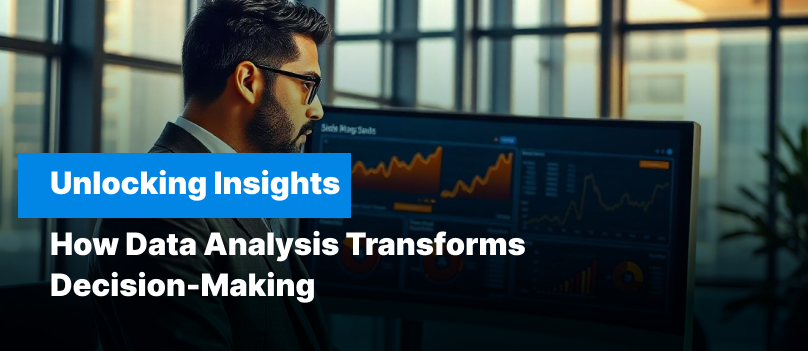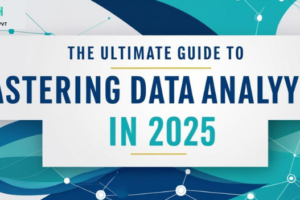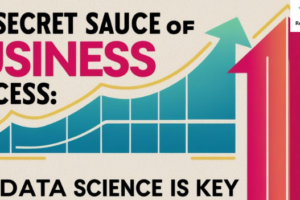
Unlocking Insights: How Data Analysis Transforms Decision-Making
- Date January 13, 2025
Introduction
In the vastly and increasingly intricate business environment of the present day – the only definite factor being change itself – decision-making has become a highly nuanced craft. The days when choices were made according to feeling, hunches, and intuitions are no longer relevant in business. Whether it’s a fledgling startup forging its path, an avant-garde team within a colossal corporation, or the stately machinery of a global conglomerate, they all grapple with a pressing dilemma: the urgent need for swift and informed decision-making. Across this multifaceted narrative, data analysis emerges as an indispensable lighthouse of clarity—an illuminating force steering organizations toward strategic shores.
Consider this reality: data is often dubbed the new oil; but unlike oil, it does not become useful until refined and distilled through insightful analysis. This process cultivates innovation and supercharges performance. So, let’s ponder this tantalizing conundrum: How exactly does data analysis reshape the very foundation of contemporary decision-making? What are the crucial components that enhance its effectiveness?Just as important, and why it is crucial for the leaders of today to embrace the use of analytics techniques, is the following question: Make yourself ready to dive in an enriching journey across the fascinating world of data analytics and its incredible transformation of decision making.
The Power of Data Analysis in Today's Landscape
Deciphering Data Analysis
Let’s demystify the complexity surrounding data analysis; this term is far more than a passing trend in the digital lexicon. It embodies a structured and deliberate process for scrutinizing, cleaning, transforming, and interpreting extensive datasets, with a singular aim: to reveal invaluable insights, draw meaningful conclusions, and empower informed decision-making. At its core, the practice metamorphoses raw data into actionable intelligence. Let’s dissect this concept further:
Raw Data: Visualize raw data as unrefined gold—a treasure waiting to be discovered. This primitive information is collected from various sources: customer interactions, operational metrics, social media feeds, and more.
Cleaning: This critical phase resembles sculpting a masterpiece from a block of marble; it involves rectifying inaccuracies, eliminating duplicates, and addressing data gaps to maintain integrity. Here, meticulous attention to detail becomes paramount—garbage in, garbage out!
Transformation: Think of this step as shaping clay into a usable form. Data undergoes techniques such as normalization, aggregation, and enrichment to prepare it for analysis.
Modeling: This phase introduces a sophisticated choreography with algorithms. By employing statistical and computational methodologies, organizations glean deeper insights, uncovering patterns that lay the groundwork for future strategies.
Why Data Matters
As we navigate the boundless digital age, the sheer volume of data created each day is staggering—approaching 2.5 quintillion bytes! But why is data an irreplaceable asset in today’s saturated markets? Here are several thought-provoking reasons that merit serious contemplation:
Informed Decisions: Strategic choices rooted in robust data analysis rather than mere intuition don’t just transform corporate maneuvers—they rewrite the very trajectory of organizations!
Competitive Edge: In a relentless sprint toward market dominance, data casts a spotlight on trends and insights that empower businesses to stay strides ahead of their competitors.
Resource Optimization: A nuanced understanding of data enables the efficient allocation of resources, significantly boosting productivity and profitability.
Enhanced Customer Experiences: Meticulously analyzing data unveils customer behaviors and preferences, propelling organizations to craft tailored offerings that resonate profoundly with target audiences.
Unlocking Insights: Key Techniques in Data Analysis
1. Descriptive Analytics
Descriptive analytics serves as a reflective mirror, offering a panoramic view of historical data while tackling a fundamental question: What transpired? This method draws upon statistical measures and potent visualization tools to extract insights from past performances and emerging trends.
Key Metrics:** Performance measures regarding key performance indicators (KPIs) are important in regard to assessing an outcome as well as in planning the further development. These metrics serve as the navigational stars, guiding an organization’s journey.
Visualizations: Engaging visuals—charts, graphs, and infographics—transform raw data into compelling narratives. This conversion enhances comprehension and fosters impactful storytelling within the data realm.
2. Predictive Analytics
Propelling us into the future, predictive analytics embarks on a quest to foresee trends—drawing insights from historical data. Picture it as a sophisticated crystal ball, offering glimpses that fuel strategic foresight!
Algorithms: Here, advanced machine learning algorithms emerge as key players, intricately identifying patterns and correlations within the vast data ocean.
Scenarios: Organizations can craft intricate models simulating various potential outcomes, empowering proactive planning and adaptive strategies, thus enhancing resilience.
3. Prescriptive Analytics
Prescriptive analytics takes a step beyond mere forecasting; it offers thoughtful recommendations for actionable strategies! By assessing various outcomes, this method enables organizations to formulate informed recommendations.
Decision Models: These models leverage optimization algorithms and simulation techniques to propose optimal courses of action. They analyze potential scenarios, balancing costs, benefits, and predicted outcomes.
Resource Allocation: This insight opens pathways for judicious resource distribution, ensuring maximum impact in execution.
The Tools of the Trade
Equipped with essential insights about various analytical methodologies, it’s vital to explore the suite of tools available to facilitate effective data analysis. Below lies a glimpse into the stalwarts of industry—software renowned for excellence:
1. Tableau
In the vibrant realm of data visualization, Tableau shines as a pillar of innovation. This sophisticated tool empowers users to create interactive, shareable dashboards that reveal insights at a glance, solidifying its standing among data analysts.
2. Microsoft Power BI
Power BI transforms extensive datasets into visually compelling accounts. With its intuitive interface, users can craft highly interpretable reports and dashboards—turning data into not just accessible but gripping narratives.
3. Python and R
For those eager to engage directly, programming languages like Python and R are unrivaled in versatility and power. Armed with robust libraries, they provide extensive capabilities for statistical analysis, data manipulation, and graphical representation.
4. Excel
The ageless classic—Excel—continues to reign supreme as an invaluable tool for data management and analysis. With dynamic pivot tables, advanced graphing functionalities, and extensive computational capabilities, it remains foundational across countless organizations.
Implementing Data Analysis in Decision-Making
The pivotal inquiry emerges: How can organizations seamlessly integrate data analysis into their decision-making frameworks? Let’s outline a structured roadmap that will serve as your compass through this intricate terrain.
Step 1: Define Objectives
What ignites the exploration into data? Is it about enhancing customer loyalty, streamlining operations, or amplifying sales? Establishing clear objectives is fundamental—it lays the groundwork for effective analysis.
Step 2: Data Collection
Gathering relevant data from reliable sources is paramount. This process encompasses internal data from various departments (sales, marketing, operations) and external data from market research or competitive analyses—here, precision is crucial for fruitful collection!
Step 3: Analyze the Data
Engage with the previously detailed techniques—descriptive, predictive, and prescriptive analytics—to distill invaluable insights from your dataset. Each analytical approach serves a unique purpose, deeply enriching your analytical practices.
Step 4: Make Informed Decisions
With insights in hand, utilize them to guide strategic decision-making! This collaborative effort should embrace key stakeholders, fostering alignment and buy-in throughout the organization.
Step 5: Monitor and Adjust
Decision-making is a fluid endeavor! Regularly monitoring outcomes and recalibrating strategies based on real-time feedback and emerging insights guarantees that your organization remains agile and responsive to shifting landscapes.
Real-World Example: How Data Analysis Changed the Game
Let’s examine a titan of industry that exemplifies data analysis excellence—Amazon. Delving into their mastery in leveraging data analysis for enhanced decision-making reveals strategies ripe for emulation.
Amazon: A Case Study in Excellence
Customer Preferences: Amazon employs advanced algorithms to meticulously analyze customer data, deftly recommending products tailored to individual tastes. This personalization not only elevates customer satisfaction but also drives astonishing sales figures.
Supply Chain Optimization: By scrupulously monitoring inventory and anticipating demand trends, Amazon expertly navigates its sprawling supply chain. This approach minimizes costs while significantly enhancing delivery speed and reliability.
Personalization: Through insightful data analysis, Amazon crafts a distinctively tailored shopping experience—boosting customer engagement and ultimately driving higher conversion rates through relevance and precision.
The industry benchmarks established by Amazon encapsulate the transformative potential of data-driven strategies within contemporary decision-making paradigms.
Conclusion
Looking at this journey, one thing is now for sure: data analysis is among the keystones of the contemporary decision-making process! The ability to turn data into useful knowledge is no longer a nice to have – it is a must-have for any organisation operating in an increasingly competitive environment. When used to their optimum, data solutions help in managing the existing forms of business volatilities, improve business operations and productivity, and drive continuing improvement.
If you have not explored how data can and will change the world, then now is the time for you to do so. Start small, gather insights, and witness your decision-making processes sharpen and elevate to unprecedented heights. With data as your unwavering ally, the horizons of opportunity expand exponentially! Are you prepared to unlock those invaluable insights? Your journey begins here!
FAQ's
Data analysis sits at the heart of every industry! From healthcare to finance, retail to manufacturing, its benefits spiral widely, transforming operational and strategic effectiveness on a grand scale.
Small enterprises can enrich their data analysis journey by utilizing user-friendly, cost-effective tools like Google Analytics, social media insights, and even foundational platforms like Excel to uncover meaningful insights that drive robust decision-making.
Absolutely not! While larger enterprises might wrestle with voluminous datasets, small and medium-sized organizations can equally harness data analysis to optimize operations and stimulate growth.
Absolutely! Nonetheless, they will be able to manage their operations optimally, have well-made decisions and grow through analysing their relatively small set of data.
You may also like

The Ultimate Guide to Mastering Data Analysis in 2025


